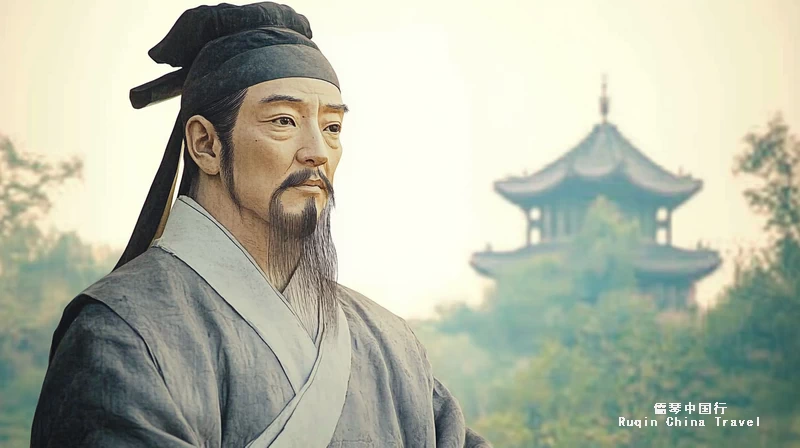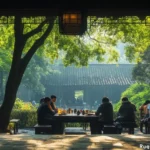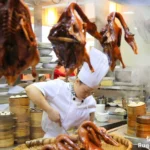Du Fu Thatched Cottage is a must-visit destination for anyone traveling to Chengdu. This historical site honors the famous Tang Dynasty poet Du Fu, who is often called China’s “Sage of Poetry.” Set within a peaceful 24-acre park, this scenic spot combines natural beauty with cultural significance. It’s perfect for visitors interested in both poetry and history. In this guide, we’ll cover everything you need to know How to Visit Du Fu Thatched Cottage , from the best time to visit to top attractions at the site.
1. Who Was Du Fu?
Before learning how to visit Du Fu Thatched Cottage, it’s important to know why this site exists. Du Fu (杜甫) is considered one of China’s greatest poets. Born in 712 during the Tang Dynasty, Du Fu lived through a tumultuous period in Chinese history, including wars and natural disasters. His poems reflect his concerns about the suffering of ordinary people and his love for the country.
In 759, Du Fu fled to Chengdu during a time of unrest and built a small thatched cottage by a stream. He lived here for about four years, writing over 240 poems. Many of these poems lament the hardships of life, while others celebrate the beauty of nature. Today, his former residence is a cultural and historical landmark that attracts visitors from all over the world.
2. How to Get to Du Fu Thatched Cottage from Chengdu
Getting to Du Fu Thatched Cottage is simple, as it’s located on the western outskirts of Chengdu, about 5 kilometers (3 miles) from the city center.
Address: No. 37 Qinghua Road, Qingyang District, Chengdu
You have several transportation options:
By Metro
The most convenient way to reach the cottage is by taking Chengdu Metro Line 4. Get off at Cultural Palace Station (Caotang Station). From there, it’s a 10-minute walk to the entrance. The metro is a fast and affordable option, taking around 15-20 minutes from the city center.
By Bus
You can also take several buses, including Bus 19, 35, 58, or 82, all of which stop near the Du Fu Thatched Cottage. The bus ride may take longer depending on traffic, but it’s another budget-friendly option.
By Taxi or Ride-hailing Apps
For those who prefer more convenience, taking a taxi or using ride-hailing apps like Didi is quick and straightforward. From downtown Chengdu, the taxi ride takes about 15-20 minutes, depending on traffic conditions.
3. Du Fu Thatched Cottage Entrance Fees and Opening Hours
Before planning your trip, it’s essential to know the Du Fu Thatched Cottage entrance fees and opening hours.
Entrance Fee: General admission is 50 RMB. Discounts are available for students and seniors.
Opening Hours: The site is open daily from 8:00 AM to 6:00 PM. The last admission is at 5:30 PM. We recommend arriving earlier in the day to avoid crowds and to explore the site at a leisurely pace.
Ticket Purchase Methods: Visitors can book tickets up to 7 days in advance through the “Du Fu Thatched Cottage Museum” official WeChat account or the “Chengdu Du Fu Thatched Cottage Museum Online Ticketing System” with real-name registration. Alternatively, tickets can be purchased on-site at the ticket window by presenting your ID card. It is recommended to book tickets in advance.
4. Best Time to Visit Du Fu Thatched Cottage
The best time to visit Du Fu Thatched Cottage is during spring (March to May) or autumn (September to November), when the weather is pleasant, and the gardens are in full bloom. Spring is particularly beautiful, as the park’s flowers and trees come to life. Autumn also provides a peaceful atmosphere, with cooler temperatures and fewer crowds.
If you visit in summer, be prepared for hot and humid weather. Winter, on the other hand, is quieter but can be chilly. No matter the season, the park’s tranquil setting makes it a wonderful retreat from the hustle and bustle of Chengdu.
5. Things to Do at Du Fu Thatched Cottage
There are plenty of things to do at Du Fu Thatched Cottage, from exploring historical exhibits to enjoying the natural surroundings. The site is divided into several key areas, each offering a unique glimpse into Du Fu’s life and legacy.
Explore Du Fu’s Thatched Cottage (茅屋)
The heart of the site is a reconstruction of Du Fu’s thatched cottage, where he lived and wrote his famous poems. Although the original cottage no longer exists, the current structure faithfully replicates its design. Inside, you’ll find displays that explain the daily life of Du Fu and the inspiration behind his poetry.
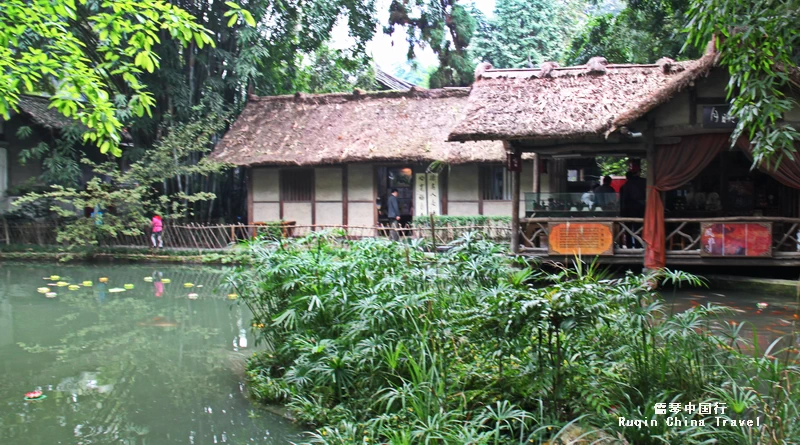
Visit the Du Gongbu Memorial Temple (工部祠)
The Du Gongbu Memorial Temple is a major attraction at the site. This hall is dedicated to honoring Du Fu. Because Du Fu once served as an advisor and official in the Ministry of Works, he was called Du Gongbu. The temple takes its name from this title.
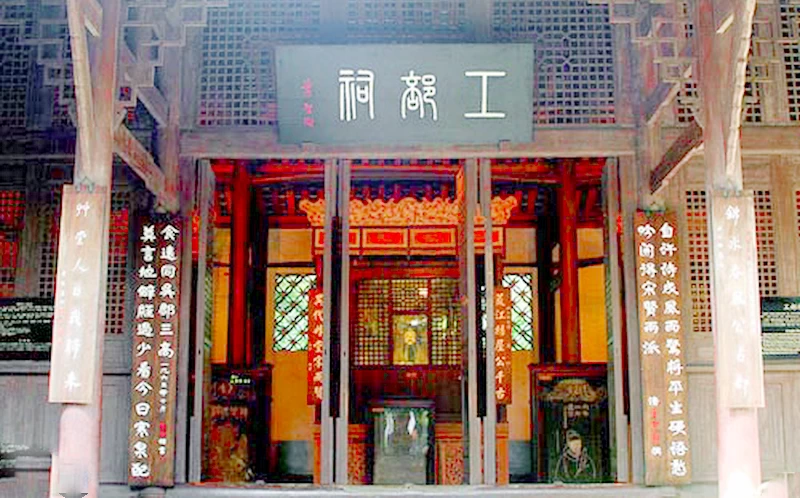
The temple has a dignified and solemn design, with a three-bay structure, mountain-shaped beams, high stone steps, and decorative lattice windows. Inside, there are stone carvings of Du Fu from the Ming and Qing dynasties. Among them, the earliest is a half-body stone carving from 1602 (Ming Dynasty Wanli Year 30), which is the oldest surviving stone image of Du Fu at the cottage.
Stroll Through the Hall of Great Poets (大雅堂)
Another key attraction is the Hall of Great Poets (Dayatang). This hall pays tribute to famous poets from China’s history, and its serene setting offers a great place for reflection. You can also see calligraphy and artwork related to Chinese poetry.

Dayatang was originally the Main Hall of Caotang Temple. It was named after Huang Tingjian’s work, “Record of Dayatang,” a famous Northern Song Dynasty literary figure. The hall officially opened in 2002. The plaque above the entrance bears the three characters “Dayatang,” written in the style of the renowned Tang Dynasty calligrapher Yan Zhenqing.
Inside Dayatang, you’ll find the largest lacquer mural with colorful inlays in China, along with 12 sculptures of famous poets throughout history. These displays vividly illustrate Du Fu’s life and the development of classical Chinese poetry. The permanent exhibition, “The Sage of Poetry Through the Ages,” won the Best Creativity Award at the fifth National Top Ten Exhibitions competition.
Tang Dynasty Ruins Exhibition Hall(唐代遗址陈列馆)
The Tang Dynasty Ruins Exhibition Hall is located in the northeast area of Du Fu Thatched Cottage. At the end of 2001, a large Tang Dynasty living site and a collection of artifacts were discovered during excavations. This find greatly enriched the historical and cultural significance of the cottage.
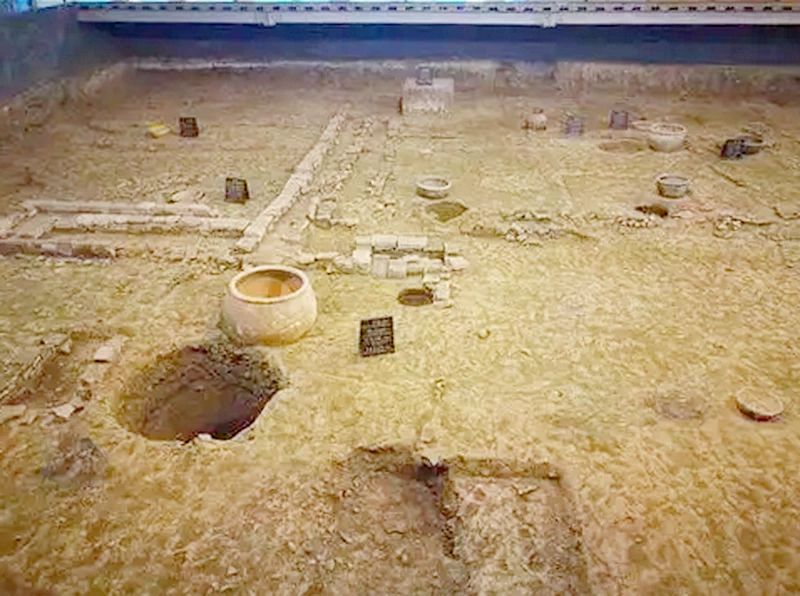
It also confirmed Du Fu’s descriptions of his living environment and lifestyle. Additionally, it verified that Du Fu’s cottage has been rebuilt on the original site over generations. This discovery clarified the debate about the location of the ancient and modern cottage, adding a deeper sense of history to Du Fu Thatched Cottage
Wander Through the Gardens and Flowery Path (花径)
For nature lovers, the gardens at Du Fu Thatched Cottage are a highlight. You can stroll along the Flowery Path, enjoy the tranquil ponds, or simply relax under the shade of the trees. The gardens were designed to reflect Du Fu’s poetic love for nature, making them a perfect spot for reflection.
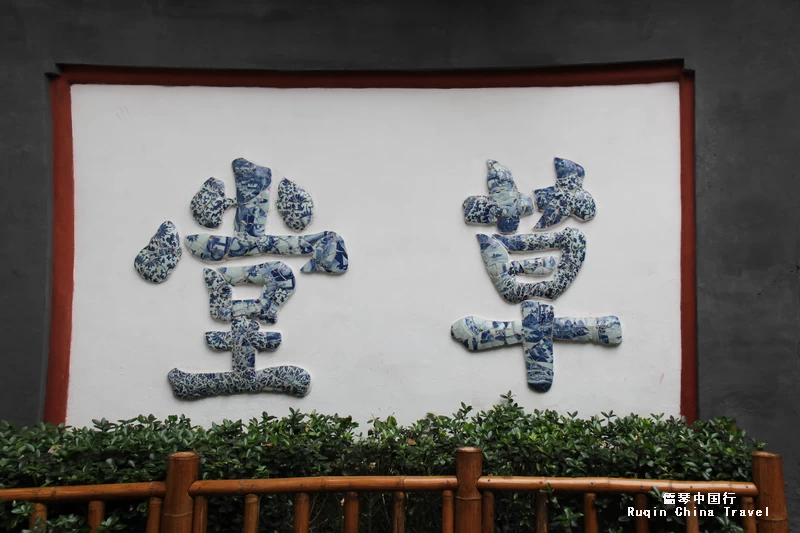
In one of his poems, Du Fu wrote, “The flower path has not been swept for guests, but today my humble gate opens for you.” Today’s Flower Path is a narrow walkway lined with red walls that connects the Du Fu Thatched Cottage memorial buildings to the original Caotang Temple. At the end of the path stands the Caotang Shadow Wall (草堂影壁), where the characters “Caotang” (草堂) are embedded in blue-and-white porcelain shards. These characters were crafted by Zhou Shanpei, a Sichuan official during the late Qing Dynasty. The wall has been damaged and restored multiple times.
Visit Wanfo Pagoda (万佛楼)
Rebuilt in 2005, the Wanfo Tower stands tall in the sandalwood forest on the east side of Du Fu Thatched Cottage. It restores the historic look of Chengdu, once known for “Chongli Pavilion in the east and Wanfo Tower in the west.”
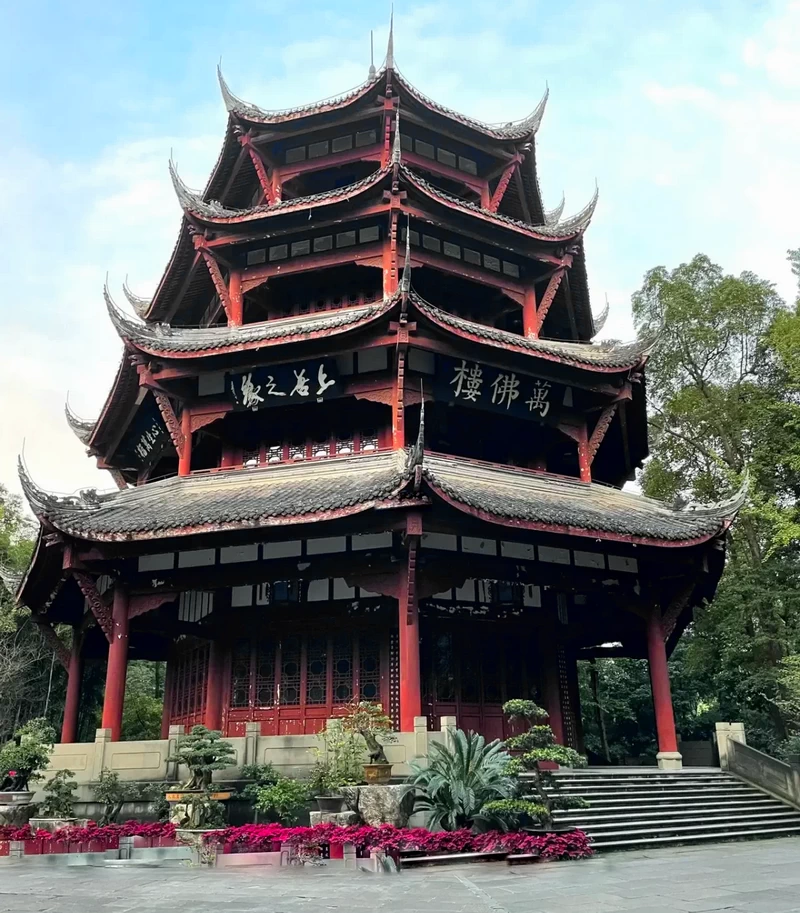
From the tower’s railing, visitors can enjoy sweeping views of the beautiful surroundings. The Wanfo Tower is now another iconic structure at Du Fu Thatched Cottage and a new cultural tourism highlight.
Visit Shaoling Thatched Tablet Pavilion (少陵碑亭)
The Shaoling Stele Pavilion is one of the most iconic structures at Du Fu Thatched Cottage. This pavilion, topped with a thatched roof, houses a stone stele inscribed with the characters “Shaoling Cottage.” The writing is bold yet elegant, penned by Prince Guo Yunzhi. In 1734 (the twelfth year of the Yongzheng reign), Prince Guo visited the cottage on his way to escort the Dalai Lama to Tibet and left behind this calligraphy.
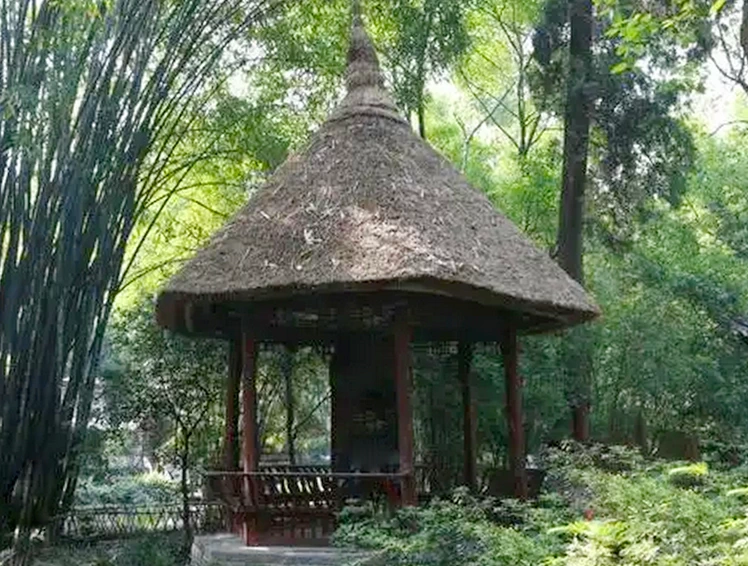
As one of the most representative spots at the museum, the Shaoling Stele Pavilion is often seen as a symbol of Du Fu’s humble cottage, and many visitors consider it a must-see.
6. Cultural Significance of Du Fu Thatched Cottage
The cultural significance of Du Fu Thatched Cottage is immense. As one of China’s most revered poets, Du Fu’s works reflect the social and political struggles of his time. His poetry is celebrated not just for its beauty but for its deep empathy for the suffering of others.
The cottage is more than just a museum; it’s a symbol of Chinese literary heritage. Chengdu poets and Du Fu share a strong connection, as the city has produced many great writers over the centuries. Visiting the cottage allows you to connect with this rich literary tradition and appreciate the profound impact Du Fu has had on Chinese culture.
7. Du Fu Thatched Cottage vs. Other Chengdu Attractions
If you’re wondering how Du Fu Thatched Cottage compares to other attractions in Chengdu, here’s a quick overview:
Wuhou Shrine: This is dedicated to the famous strategist Zhuge Liang. While Wuhou Shrine focuses on the Three Kingdoms period, Du Fu Thatched Cottage focuses on the literary world.
Jinsha Site Museum: For those more interested in archaeology and ancient history, the Jinsha Site Museum offers a different cultural experience. However, Du Fu’s cottage provides a more tranquil and reflective atmosphere.
Both sites are rich in history, but the cottage offers a unique opportunity to explore China’s literary heritage.
8. Photography Spots at Du Fu Thatched Cottage
For photography enthusiasts, there are plenty of photography spots at Du Fu Thatched Cottage. The Flowery Path and the gardens provide stunning natural backgrounds.
The thatched cottage itself, with its traditional architecture, is also a popular subject. Additionally, the Wanfo Pagoda and Shaoling Thatched Cottage Tablet Pavilion offer interesting architectural elements that make for great photos.
Whether you’re capturing the serene beauty of the gardens or the historic structures, you’ll find many opportunities for memorable shots.
9. Where to Stay Near Du Fu Thatched Cottage
If you want to stay close to the site, there are several accommodation options near Du Fu Thatched Cottage. Here are some recommendations:
Holiday Inn Express Chengdu West Gate: A budget-friendly option with modern amenities and easy access to the cottage.
Tibet Hotel Chengdu: This hotel offers a cultural experience with Tibetan decor and is located about 10-15 minutes from the cottage by taxi.
Waldorf Astoria Chengdu: For a more luxurious stay, this high-end hotel provides excellent service and facilities. It’s about a 20-minute drive from the site.
These options suit a range of budgets and provide convenient access to both the cottage and other attractions in Chengdu.
10. Du Fu Thatched Cottage Guided Tours
For a deeper understanding of the site, you might consider joining one of the Du Fu Thatched Cottage guided tours. These tours are available in both Chinese and English.
A guided tour will provide insights into Du Fu’s life, the significance of his poems, and the history behind the various areas of the park. If you prefer a more personalized experience, you can also hire a private guide.
11. Attractions near Du Fu Thatched Cottage
After visiting Du Fu Thatched Cottage, there are several other noteworthy attractions nearby. Just a short distance away is the Wuhou Shrine, dedicated to Zhuge Liang, a famous strategist from the Three Kingdoms period.
Another nearby spot is the Qingyang Palace, one of the most important Taoist temples in Chengdu. For nature lovers, Huanhuaxi Park, located right next to Du Fu Thatched Cottage, offers a peaceful environment for a relaxing stroll. These nearby sites complement the cultural and historical experience of visiting Du Fu Thatched Cottage.
12. Final Tips for Visiting Du Fu Thatched Cottage
To wrap up this Du Fu Thatched Cottage travel guide, here are some final tips:
Arrive early to avoid crowds, especially during weekends and holidays.
Bring comfortable walking shoes, as the park covers a large area.
Take your time to read the translations of Du Fu’s poems, as they add depth to your understanding of the site.
Check the weather before visiting, as some parts of the park are outdoors, and you’ll want to be prepared.
By following these tips, you’ll have a richer and more enjoyable experience at Du Fu Thatched Cottage.
Now that you know how to visit Du Fu Thatched Cottage, you’re ready to explore one of Chengdu’s most significant historical and cultural sites. Whether you’re a poetry lover, history buff, or simply looking for a peaceful place to enjoy nature, this beautiful park offers a unique glimpse into the life and legacy of Du Fu.
More Chengdu Travel Guides
Plan your Chengdu Tour? Our “Chengdu Travel Guide“ section offers essential advice to help you navigate the city like a pro. Welcome to the Chengdu Travel Guide, your ultimate resource for exploring the vibrant heart of Sichuan Province. Known as the home of the giant pandas and the birthplace of spicy Sichuan cuisine, Chengdu is a city where ancient traditions meet modern life.

